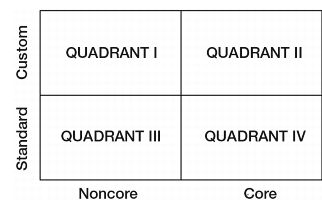A quadrant approach classifies all Postal Service purchases into four categories, depending on their impact on the Postal Service core competencies (noncore versus core) and complexities (standard versus custom). The level and depth of understanding of client needs, goals, and strategies will vary depending on the complexity and criticality of the purchase. Approaches to defining and understanding client needs, goals, and strategies will have to be aligned to the applicable quadrant, illustrated in Figure 1.2.
Figure 1.2
Four Quadrants

Products and services in this quadrant do not provide direct value to the end client, but contribute significantly to the supporting capability function. Clients’ goals and strategies must be understood because they are customized to the business function.
Products and services in this quadrant create direct value for the end client; there should be continuous work with these clients to understand their needs, goals, and strategies.
Products and services in this quadrant are essential to support the business infrastructure, but do not relate or provide value to the end client. These clients’ objectives should be understood, but it is not necessary to spend inordinate amounts of time conducting research or interviewing clients in this quadrant.
Products and services in this quadrant create value for the end client and may require leading-edge market solutions that do not need to be customized exclusively to the business. Understanding clients’ expectations and needs in this quadrant is important; therefore, a continuous communication plan should be implemented.
